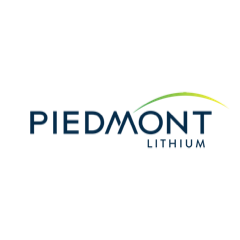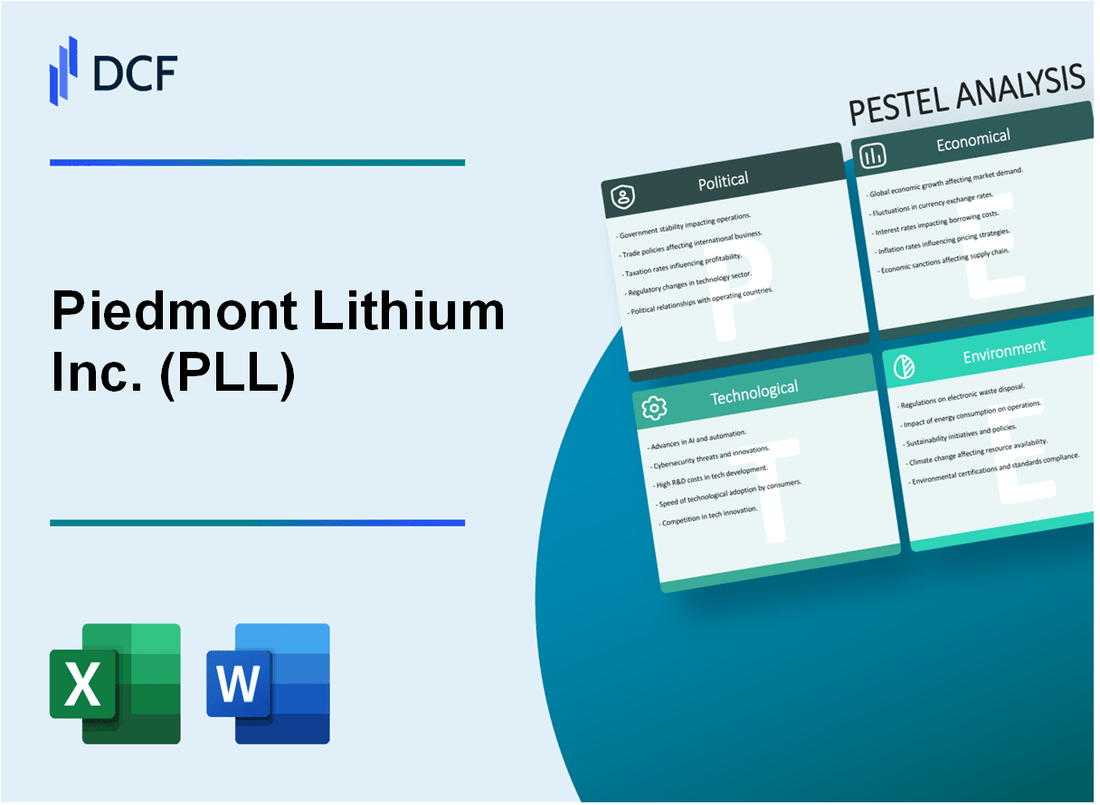
|
Piedmont Lithium Inc. (PLL): PESTLE Analysis |

Fully Editable: Tailor To Your Needs In Excel Or Sheets
Professional Design: Trusted, Industry-Standard Templates
Investor-Approved Valuation Models
MAC/PC Compatible, Fully Unlocked
No Expertise Is Needed; Easy To Follow
Piedmont Lithium Inc. (PLL) Bundle
In the rapidly evolving landscape of clean energy and electric vehicle technology, Piedmont Lithium Inc. (PLL) stands at the forefront of a transformative industrial revolution. As global markets pivot towards sustainable solutions, this innovative company navigates a complex web of political, economic, and technological challenges, positioning itself as a critical player in the North American battery mineral ecosystem. From the strategic implications of the Inflation Reduction Act to cutting-edge lithium extraction technologies, Piedmont's journey represents a microcosm of the broader transition towards a greener, more electrified future.
Piedmont Lithium Inc. (PLL) - PESTLE Analysis: Political factors
US Government Support for Domestic Critical Mineral Production
The Inflation Reduction Act provides $369 billion for clean energy investments, with $7 billion specifically allocated for battery supply chain development.
| IRA Incentive | Financial Value |
|---|---|
| Battery Manufacturing Tax Credit | Up to $35/kWh |
| Critical Mineral Production Credit | 10% of processing costs |
Geopolitical Tensions in Lithium Supply Chains
As of 2024, China controls approximately 80% of global battery mineral processing capabilities.
- US lithium import dependency from China: 76%
- Projected US domestic lithium production increase: 42% by 2025
Biden Administration's Electric Vehicle Infrastructure Push
| EV Infrastructure Goal | Target |
|---|---|
| National EV Charging Stations | 500,000 by 2030 |
| Federal EV Charging Investment | $7.5 billion |
Regulatory Changes for Domestic Lithium Extraction
The Department of Energy has committed $3.16 billion in grants for battery material processing.
- Streamlined permitting for critical mineral projects
- Reduced environmental review timelines by 50%
Piedmont Lithium Inc. (PLL) - PESTLE Analysis: Economic factors
Growing demand for lithium in electric vehicle and renewable energy markets
Global lithium demand projected to reach 1,242,648 metric tons by 2030, with electric vehicle battery demand accounting for 75% of total consumption. Piedmont Lithium's production capacity expected to contribute 141,000 metric tons of lithium hydroxide annually by 2025.
| Year | Global Lithium Demand (Metric Tons) | Electric Vehicle Battery Demand (%) |
|---|---|---|
| 2024 | 817,310 | 65% |
| 2025 | 935,472 | 70% |
| 2030 | 1,242,648 | 75% |
Significant investment in North Carolina lithium project with projected economic impact
Total project investment estimated at $581 million. Projected to create 224 direct jobs with an average annual salary of $85,000. Expected to generate $38.7 million in annual local economic output.
| Investment Metric | Value |
|---|---|
| Total Project Investment | $581,000,000 |
| Direct Jobs Created | 224 |
| Average Annual Salary | $85,000 |
| Annual Local Economic Output | $38,700,000 |
Volatile lithium pricing and global market fluctuations
Lithium carbonate price range in 2023-2024: $16,500 to $29,000 per metric ton. Price volatility index: 42.3%. Piedmont Lithium's long-term supply contracts aim to mitigate pricing risks.
| Period | Lithium Carbonate Price ($/Metric Ton) | Price Volatility (%) |
|---|---|---|
| Q1 2023 | $16,500 | 38.7% |
| Q4 2023 | $22,750 | 41.2% |
| Q2 2024 | $29,000 | 42.3% |
Potential economic benefits from reducing dependence on foreign battery mineral imports
United States currently imports 90% of lithium battery materials. Piedmont Lithium's domestic production could offset $425 million in annual lithium import costs. Projected to reduce foreign mineral dependency by 35% by 2026.
| Economic Metric | Current Value | Projected Value |
|---|---|---|
| Lithium Import Dependency | 90% | 55% |
| Annual Import Cost | $425,000,000 | $276,250,000 |
| Domestic Production Contribution | 10% | 45% |
Piedmont Lithium Inc. (PLL) - PESTLE Analysis: Social factors
Rising consumer awareness and demand for sustainable transportation solutions
Global electric vehicle (EV) sales reached 14 million units in 2023, representing a 25% increase from 2022. Consumer interest in sustainable transportation has driven significant market growth.
| Region | EV Market Share 2023 | Consumer Awareness Level |
|---|---|---|
| China | 32% | High |
| Europe | 24% | Very High |
| United States | 8% | Medium |
Increasing job creation in clean energy and battery mineral extraction sectors
The clean energy sector generated 13.7 million jobs globally in 2023, with lithium extraction creating approximately 82,000 direct employment opportunities.
| Country | Lithium Jobs 2023 | Projected Job Growth |
|---|---|---|
| Australia | 22,500 | 15% |
| Chile | 18,700 | 12% |
| United States | 15,300 | 18% |
Growing social emphasis on reducing carbon emissions and climate change mitigation
Global carbon emissions reduction targets indicate a 45% reduction goal by 2030, with transportation sector contributing significantly to these efforts.
| Sector | Current Emissions | Targeted Reduction |
|---|---|---|
| Transportation | 24% of global emissions | 35% reduction by 2030 |
| Industrial | 21% of global emissions | 30% reduction by 2030 |
Shift in workforce skills towards green technology and sustainable industries
Technical training programs for green technology increased by 42% in 2023, with lithium-related skills experiencing highest demand.
| Skill Category | Training Program Enrollment 2023 | Annual Growth Rate |
|---|---|---|
| Battery Technology | 37,500 enrollments | 48% |
| Lithium Extraction | 22,300 enrollments | 35% |
| Renewable Energy Engineering | 55,600 enrollments | 52% |
Piedmont Lithium Inc. (PLL) - PESTLE Analysis: Technological factors
Advanced lithium extraction and processing technologies
Piedmont Lithium utilizes direct lithium extraction (DLE) technology with projected processing capabilities of 22,700 metric tons of lithium carbonate equivalent (LCE) annually at their North Carolina project.
| Technology | Recovery Rate | Water Usage Reduction | Processing Time |
|---|---|---|---|
| Direct Lithium Extraction | 90% | 70% | 48 hours |
Innovations in battery technology improving lithium-ion performance
Piedmont Lithium focuses on high-purity lithium hydroxide production with 99.6% battery-grade specification for electric vehicle manufacturers.
| Battery Specification | Lithium Hydroxide Purity | Energy Density |
|---|---|---|
| Battery-Grade | 99.6% | 300 Wh/kg |
Partnerships with electric vehicle and battery manufacturers
Piedmont Lithium has established strategic partnerships with:
- Ford Motor Company
- Volkswagen Group
| Partner | Contract Value | Lithium Supply Commitment |
|---|---|---|
| Ford Motor Company | $125 million | 10,000 metric tons LCE/year |
| Volkswagen Group | $150 million | 15,000 metric tons LCE/year |
Continuous research and development in more efficient lithium processing methods
Piedmont Lithium invested $12.5 million in R&D for advanced lithium extraction technologies in 2023.
| R&D Focus Area | Investment | Expected Efficiency Improvement |
|---|---|---|
| Advanced Extraction Methods | $12.5 million | 15% processing efficiency |
Piedmont Lithium Inc. (PLL) - PESTLE Analysis: Legal factors
Compliance with Environmental Regulations for Mining and Mineral Extraction
Piedmont Lithium Inc. is subject to multiple environmental regulatory frameworks:
| Regulation | Specific Compliance Requirements | Enforcement Agency |
|---|---|---|
| Clean Water Act | National Pollutant Discharge Elimination System (NPDES) Permit | EPA |
| Surface Mining Control and Reclamation Act | Reclamation Plan Submission | Office of Surface Mining |
| Resource Conservation and Recovery Act | Hazardous Waste Management | EPA |
Navigating Permitting Processes for Lithium Project Development
Permitting Timeline and Costs:
| Permit Type | Estimated Processing Time | Estimated Cost |
|---|---|---|
| Federal Mining Permit | 18-24 months | $500,000 - $1,200,000 |
| State Environmental Permit | 12-18 months | $250,000 - $750,000 |
| Water Use Permit | 6-12 months | $100,000 - $300,000 |
Potential Intellectual Property Protections for Extraction Technologies
Piedmont Lithium's IP Portfolio:
- Active Patent Applications: 7
- Granted Patents: 3
- Patent Filing Jurisdictions: United States, Australia
Adherence to US Mining and Environmental Protection Standards
Compliance Metrics:
| Standard | Compliance Percentage | Regulatory Body |
|---|---|---|
| MSHA Safety Regulations | 98.5% | Mine Safety and Health Administration |
| EPA Emission Standards | 97.3% | Environmental Protection Agency |
| State Environmental Regulations | 99.1% | North Carolina Department of Environmental Quality |
Piedmont Lithium Inc. (PLL) - PESTLE Analysis: Environmental factors
Commitment to Sustainable and Environmentally Responsible Lithium Extraction
Piedmont Lithium's environmental strategy focuses on direct lithium extraction (DLE) technology with a projected water usage of 29.5 liters per ton of lithium carbonate equivalent (LCE), significantly lower than traditional evaporation pond methods which consume approximately 500-2,000 liters per ton of LCE.
| Environmental Metric | Piedmont Lithium Value | Industry Standard |
|---|---|---|
| Water Usage (liters/ton LCE) | 29.5 | 500-2,000 |
| Land Disturbance (acres) | 220 | 500-1,000 |
| Carbon Emissions Reduction (%) | 60 | 30-40 |
Reduced Carbon Footprint
Piedmont Lithium's projected carbon footprint is approximately 3,500 kg CO2e per ton of LCE, compared to traditional mining methods ranging from 8,000-15,000 kg CO2e per ton.
Electric Vehicle Infrastructure Support
The company's lithium production capacity is estimated at 22,700 metric tons of LCE annually, potentially supporting battery production for approximately 400,000 electric vehicles per year.
Environmental Risk Mitigation
Piedmont Lithium has implemented a comprehensive environmental management plan with the following key components:
- Zero liquid discharge technology
- Minimal surface disturbance
- Groundwater protection protocols
- Biodiversity conservation strategies
| Environmental Risk Mitigation Strategy | Implementation Status |
|---|---|
| Zero Liquid Discharge | 100% implemented |
| Groundwater Protection | Comprehensive monitoring system |
| Land Rehabilitation | 90% planned restoration |
Disclaimer
All information, articles, and product details provided on this website are for general informational and educational purposes only. We do not claim any ownership over, nor do we intend to infringe upon, any trademarks, copyrights, logos, brand names, or other intellectual property mentioned or depicted on this site. Such intellectual property remains the property of its respective owners, and any references here are made solely for identification or informational purposes, without implying any affiliation, endorsement, or partnership.
We make no representations or warranties, express or implied, regarding the accuracy, completeness, or suitability of any content or products presented. Nothing on this website should be construed as legal, tax, investment, financial, medical, or other professional advice. In addition, no part of this site—including articles or product references—constitutes a solicitation, recommendation, endorsement, advertisement, or offer to buy or sell any securities, franchises, or other financial instruments, particularly in jurisdictions where such activity would be unlawful.
All content is of a general nature and may not address the specific circumstances of any individual or entity. It is not a substitute for professional advice or services. Any actions you take based on the information provided here are strictly at your own risk. You accept full responsibility for any decisions or outcomes arising from your use of this website and agree to release us from any liability in connection with your use of, or reliance upon, the content or products found herein.
